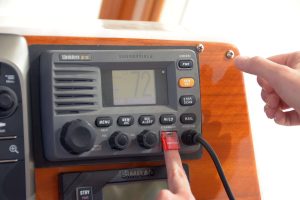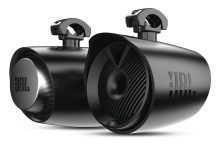
radio can make a one-button distress call that automatically includes time-saving latitude and longitude location information.
For recreational boaters, sailors and anglers, having a Digital Selective Calling (DSC) VHF radio aboard to call for emergency help will always be the fastest way to summon assistance from your closest rescuers. That means that going without one can hurt your chances for a safe summer on the water. Here are three common mistakes boat owners make with DSC-VHF radios and some simple ways to improve safety aboard your boat.
Mistake #1: Relying on an old VHF radio to signal that you are in distress – If you are using a VHF radio that was manufactured more than 15 years ago, you’re relying on old technology. There’s probably not a person around that regularly uses a 15-year-old phone, television set or computer. Today’s DSC-VHF radios have new lifesaving features, most importantly a distress button that can hail a mayday and relay your position to rescue authorities — all at the push of one little red (distress) button on the face of the radio. BoatUS has some help to set up your new DSC-VHF radio at BoatUS.com/SettingUpDSCRadio.
Mistake #2: Thinking you don’t need to bother to register a DSC-VHF and get an MMSI number — A Maritime Mobile Service Identity (MMSI) number is a unique registration number that is assigned to your vessel to be used with the vessel’s DSC-VHF radio. MMSI numbers are issued by organizations including BoatUS which offer the service at no cost to members or for a nominal $25 fee for non-members. The MMSI must be entered into the radio in order to harness all of its power and lifesaving technology. Registering your radio gives potential rescuers important information about you, your boat and whom to contact in an emergency.
Mistake #3: Not reading the owner’s manual that came with your radio and familiarizing yourself with your radio’s features — Your DSC-VHF radio manual contains a ton of great information about the features of your radio and how to install it. If your radio is not properly installed or not connected to your boat’s GPS or chartplotter, you’re shortchanging yourself and perhaps unknowingly putting yourself and your crew in danger if there is a delay in transmission and emergency response.
Digital Selective Calling technology can also make your everyday boating better. In addition to being able to send a distress signal with the press of a button, a DSC-VHF radio can privately hail other DSC-VHF-equipped vessels or groups of boats without tying up VHF channel 16, the distress, safety and calling frequency. It also allows you to ‘ring’ (hail) others if you know their MMSI numbers without them having to monitor a particular channel.
If you haven’t yet purchased a DSC-VHF radio, make it one of your safety-gear equipment priorities this season.































